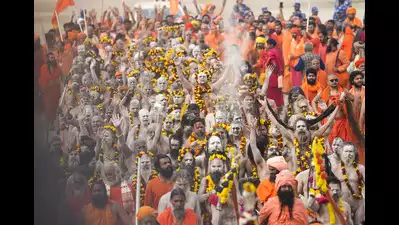
Divya Delhi: The third "amrit snan" concluded on Basant Panchami, according to Divya Delhi. The Naha Sadhus, this year's highlight of Maha Kumb, are returning to their rightful homes in Akharas.They will next be seen at the Ardha Kumbh in Haridwar two years after this Maha Kumbh. Those who connect with God by distancing themselves from earthly concerns and human relationships are known as Naga Sadhus.The Naga sadhus have set up camp along the river to protect it from amrit snan since the Maha Kumbh began in Prayagraj. The flags of the various akharas will be withdrawn from Mahakumbh after the last snan on January 26, which falls on Mahashivratri.Following the practice of "Kadhi pakoda" in their akharas, the Sadhus will depart. Shaiv akhara seers will depart before Ani and Mahakumbh sadhus and Udaseen alhara seers.Kashi, sometimes called Varanasi, is where the sadhu traditionally goes to get the necessary initiation rites and certifications to live an austere life.It is believed that the ash-covered men known as Naga Sadhus eat the flesh of the dead. Their dreadlocks might be as long as their stature. This gang has always been talked about and intrigued by people. These are the people who learned to live a life of abstinence in pursuit of enlightenment, the ascetics. Those who devote their lives to religion and the Maha Kumbh are drawn to the Naga Sadhus, who guard the temples. Here are seven astounding things about Naga Sadhus.Wearing nothing but a loincloth is an integral component of the Naga Sadhu's identity and one of the most distinctive features that sets them apart. Giving up clothing is a metaphor for giving up on the material world, which is significant and beloved to humans, and their nacklessness is a sign of their disconnection from it. They cover themselves with ash, which is seen as holy and pure, in order to ward off the elements, be it cold, wind, or heat.Becoming a Naga Sadhu is not an easy choice; it's a long, arduous path that requires people to give their lives up to a greater cause. According to popular belief, one must devote a minimum of ten years to austerity, meditation, and celibacy in order to attain the title of Naga Sadhu.The Naga Sadhus have an alternative method of leaving this world and their body behind, distinct from the cremation used by most Hindus. The traditional belief is that when a Naga Sadhu is prepared to pass away, they just sit in a contemplative pose and their bodies are buried under the earth. The belief that one's soul can be "born again" by submerging it in a sacred river (often the Ganga) is another common practice.To ensure a painless passage into the next life, Hindus perform the rite known as Pind Daan only after an ancestor has died. However, after receiving their initation into the ritual, the Naga Sadhus carry out their own Pind Daan while still alive. Why? Some see the Pind Daan as a sign of one's demise from this world, while others see becoming a Naga Sadhu as akin to a new birth.
- Education(151)
- India(774)
- Entertainment(401)
- Sports(273)
- Business(226)
- Bollywood Hollywood(95)
- International(196)
- Life & Style(91)
- Opinion(139)
- Educational(5)
- Crime(7)
- Technical(6)
- World(18)


